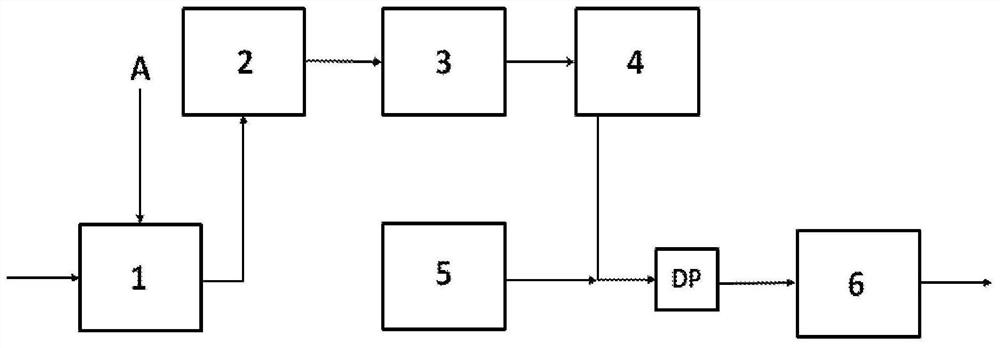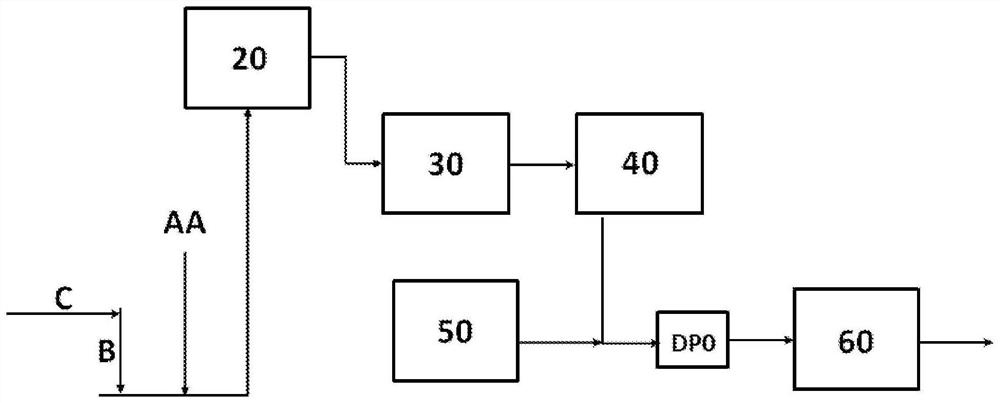A process for producing paper or board and a product thereof
A technology for pulp and fiber, applied in the field of paper or board production, can solve the problems of holes or dark spots, reduce paper quality, printing machine pollution, etc., to reduce the reduction of internal strength, improve runability, improve strength and smoothness degree of effect
- Summary
- Abstract
- Description
- Claims
- Application Information
AI Technical Summary
Problems solved by technology
Method used
Image
Examples
Embodiment 1
[0115] exist figure 1 A diagram according to one embodiment of the invention is given in . The method comprises: adding a high molecular weight polymeric papermaking additive (A) as a powder or an aqueous dispersion to a pulper (1) containing a dry fiber stock. High molecular weight polymeric paper additives are evenly distributed over the stock in the pulper. The stock is directed to a disintegrator and / or refiner (2), from which the crushed and / or refined stock is directed to a mixing tank (3) and from there to a pulping tank ( 4). The stock is then diluted with white water from the white water tank (5) to obtain a thin stock which is directed to the headbox (6) to form a web which is subsequently dried. Optional cationic agent can be added to the mixing box (3), machine chest (4), white water tank (5), before the dilution pump (DP), or after the dilution pump (DP) but after the flow In the thin slurry before the box (6).
Embodiment 2
[0117] exist figure 2 A diagram according to another embodiment of the present invention is given in . The method comprises: feeding a high molecular weight polymeric papermaking additive (AA) as an aqueous dispersion into a fiber line containing an undried fiber slurry, prior to a disintegrator and / or refiner (20), but After the chip line (C) and bleach line (B) of the integrated paper mill. The cracked and / or refined stock is directed to a mixing box (30) and from there to a machine chest (40). The stock is then diluted with white water from the white water tank (50) to obtain a thin stock which is directed to the headbox (60) to form a web which is subsequently dried. The optional cationic agent can be added to the mixing box (30), machine chest (40), white water tank (50), before the dilution pump (DPO), or after the dilution pump (DPO) but after the flow In the thin slurry before the box (60).
Embodiment 3
[0119] The effect of the present invention on fiber refining was tested by adding 2 kg / t high molecular weight CMC to acacia pulp, adding the pulp to a valley beater, and cycling for 30 minutes without load to disintegrate. Acacia pulp without CMC was used as a reference. The same refining time was used for pulp with and without CMC. The Canadian Freeness (in ml) of the pulp was measured according to ISO 5267-2 before and after refining. Due to the water-holding properties of CMC, the addition of CMC reduced the freeness (pulp displacement in milliliters) by about 10% even before refining and by about 18% after refining compared to the reference value. This shows that by using the present method, a higher level of refining (reduced freeness) can be obtained using the same energy, or the same freeness can be obtained using less energy.
[0120] The following tensile strength, z-direction strength and bulk tests were carried out on 80 gsm handsheets made from the above refined...
PUM
| Property | Measurement | Unit |
|---|---|---|
| molecular weight | aaaaa | aaaaa |
| degree of polymerization | aaaaa | aaaaa |
Abstract
Description
Claims
Application Information
 Login to View More
Login to View More - R&D
- Intellectual Property
- Life Sciences
- Materials
- Tech Scout
- Unparalleled Data Quality
- Higher Quality Content
- 60% Fewer Hallucinations
Browse by: Latest US Patents, China's latest patents, Technical Efficacy Thesaurus, Application Domain, Technology Topic, Popular Technical Reports.
© 2025 PatSnap. All rights reserved.Legal|Privacy policy|Modern Slavery Act Transparency Statement|Sitemap|About US| Contact US: help@patsnap.com


